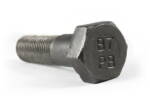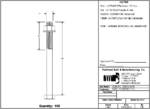Portland's FAQs
Yes, there is. A193 and A320 grades B8 and B8M are assumed to be Class 1 unless otherwise specified. Class 1 fasteners are carbide solution treated, while class 2 fasteners are carbide solution treated and strain hardened. The work hardening that occurs in the manufacturing of Class 2 fasteners increases their strength. Class 2 fasteners... Read more
Headed bolts are required to be stamped on top of the head, while most rods and some bent bolts are required to be stamped on one end. This Fastener Identification Markings Chart shows the various marking requirements for most common grades of ASTM and SAE fasteners. Headed Bolts ASTM specifications require a manufacturer’s identification and... Read more

The grade of bolt used in a Slip Critical (SC) connection has no direct bearing on the connection itself, so the answer is yes. The SC connection means that it is a type of bolted structural steel connection which relies on friction between the two connected elements rather than bolt shear or bolt bearing to... Read more
Basically, there are 3 different configurations of threads: Full-body cut thread Reduced-body rolled threads Full-body rolled threads Full Body Cut Thread Full body cut threads use full size round bar and the threads are cut into the steel. This is a commonly used method, especially on larger diameter products, long length products, and small quantity... Read more
Yes we do. Our quoting program is designed to automatically send drawings with all items we quote. We can also create any other drawings you may need. Drawings minimize the possibility of both verbal miscommunication and written misinterpretation. Our drawings will define exactly what we are planning to supply and give you the ability to... Read more

Yes. 44W / 300W is the Canadian version of A36 steel, and is a grade within the CSA G40.21-04 specification. The Canadian Standards Association specification G40.21 covers structural quality steel plates, shapes, sheet, sheet piling, cold-formed channels, hollow sections, Z sections, and bars. 44W steel has slightly higher mechanical requirements than A36, which are summarized... Read more
Hot-dip galvanizing is a process of applying a protective zinc coating by dipping product in bath of molten zinc. Galvanizing is a favored method of protective coating due to its low cost, ease of application, and long maintenance-free service life. Generally applied at 830 to 870 degrees, the zinc will bond with the steel. It... Read more
S3 is the supplemental specification for a permanent grade identification stamp on the top end of F1554 anchor bolts. When this is called out, it replaces the color code requirement. Therefore, color coding is not required when supplemental requirement S3 is called out on the purchase order. For more information on marking and color coding... Read more
The answer is yes, however, there are several issues to consider to avoid liability. For this discussion, we will assume a requirement for threaded rebar as follows: #8 x 48″ long A615 grade 60 rebar with 8″ thread one end. What is rebar? Rebar is short for “reinforcing bar” and often used in concrete foundations... Read more
Socket sizes and wrench openings for tightening nuts and bolts are determined by the dimension across the flats of either the nut or bolt head. According to the Machinery’s Handbook, 26th edition, “Wrenches are marked with the ‘nominal size of wrench’ which is equal to the basic or maximum width across flats of the corresponding... Read more
